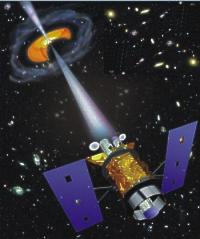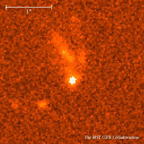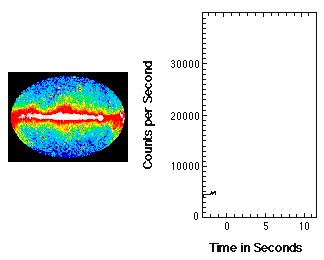SWIFT Satellite to Catch the Most Powerful Flashes of Light Known in the Universe
SWIFT Satellite to Catch the Most Powerful Flashes of Light Known in the Universe
| 26 October 1999 |
Once or twice a day, without warning, there are brief flashes of highly energetic light that momentarily outshine the rest of the universe. NASA has chosen to develop a mission that will be capable of capturing information about these unpredictable bursts of gamma-rays.
The mission, a satellite called Swift, was selected on Oct. 14 as NASA's next MIDEX (or medium-class explorer) mission. It will be developed at NASA's Goddard Space Flight Center in Greenbelt, MD.
Dr. Alan Bunner, director of NASA's Structure and Evolution of the Universe science theme said, "Gamma-ray bursts are one of the biggest mysteries in astronomy, and Swift is exactly the right tool to discover their origin. Swift's detection of gamma-ray bursts could provide a bonanza of cosmological data, for the bursts are thought to originate from the farthest reaches of the universe and hence early in the age of the universe."
 Credit: NASA |
Gamma-rays, invisible to the human eye, are the most energetic form of radiation, far more powerful than optical light, ultraviolet radiation and X-rays. Gamma-ray bursts are by far the most energetic events known in the universe, second only in power to the Big Bang. The cause of these outbursts -- which, if originated nearby in our galaxy, could cause mass extinction on Earth -- is not known.
MIDEX missions are part of NASA's goal to solve such mysteries by incorporating the latest technology into smaller satellites that can be built and launched quickly and inexpensively. Swift will be launched in 2003 and operate for three years after that for a cost of $163 million.
"We are delighted to have Swift selected as the next MIDEX," said Dr. Neil Gehrels, principal investigator for Swift and an astrophysicist at Goddard. "New agile pointing systems and telescope technology enable Swift to respond rapidly and catch hundreds of bursts on the fly. We will finally be able to get a snapshot of these flashes."
Swift is named for the small, nimble bird, as well as for its ability to swiftly turn and point its instruments. The satellite will be able to catch fluttering flashes of gamma rays that last from only a few milliseconds to a minute before fading away. An afterglow of the burst may linger in X-ray and optical light for a few hours to a few days.
 HST image of the optical afterglow of a gamma-ray burst (Credit: HST GRB Collaboration/NASA) |
The Swift team expects the satellite to detect over 300 bursts a year and determine their location relative to their host galaxies, a feat which has not yet been accomplished with current telescopes, even for the most powerful and long-lasting bursts.
Swift will also be connected to the Gamma-Ray Bursts Coordinate Network, a relay system operated by Goddard that informs other satellites within seconds that a burst is occurring. This enables X-ray and optical telescopes to view the gamma-ray burst afterglow and obtain such valuable information as spectra and redshift -- all providing insight to a burst's origin.
Gehrels said that among the gamma-ray burst origin theories are such concepts as the merging of neutron stars or black holes, the formation of a massive black hole, and a star explosion called a hypernova, which is at least a thousand times more powerful than the already potent supernova. Swift will determine whether there are different classes of gamma ray bursts that could be associated with a particular origin scenario.
The main instrument aboard Swift is the Burst Alert Telescope. The telescope will detect and locate about one gamma-ray burst per day, relaying a 1-4 arc minute position to the ground within about 15 seconds. This position will then be used to "swiftly" re-point the satellite to bring the burst area into the narrower fields of view of the two other Swift instruments designed to study the afterglow: the X-ray Telescope and the UltraViolet/Optical Telescope. These longer-wavelength (lower-energy) instruments will determine an arc-second position of a burst and determine the redshift, or distance, to the burst source.
When not catching gamma-ray bursts, Swift will conduct an all-sky survey in hard X-rays that will be 100 times more sensitive than current hard X-ray telescopes. This sensitivity should uncover over 400 new supermassive black holes.
Swift is an international collaboration with partners in Italy and Great Britain. The lead university partner is Pennsylvania State University, led by Dr. John Nousek. The spacecraft partner is Spectrum Astro.
Swift is a key component of NASA's Structure and Evolution of the Universe theme, dedicated to unraveling the mysteries of the cosmos and ensuring future cosmic journeys. A detailed description of Swift is available at http://swift.gsfc.nasa.gov.

Credits: NASA/Marshall (left) and NASA/Goddard. |

